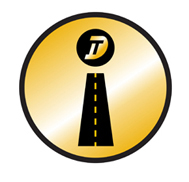

Using 3D renderings, animation to drive public engagement
and understanding of project
ITD is using new technology allowing the public and stakeholders to better grasp many complex bridge replacement projects, visualize what the department is trying to accomplish, and understand how the new bridges will fit into the town's aesthetics or existing environment. Before this, project stakeholders were often frustrated by the disconnect and may have felt like they had no say in the outcome.
By using 3D bridge renderings and animations, ITD is better able to communicate these complexities and alleviate these frustrations.
Normally, ITD has had to bring in consultants to generate these animations and renderings, and were only done on a as need bases. Throughout the last couple years, the bridge section has been able to take district or consultant 3D roadway corridors and plug them into 3D bridge models so that realistic animations and renderings can be created in house.
This has been very popular and proven extremely beneficial on several high profile bridge replacement projects:
US-20B, Broadway Bridge replacement over the Boise River (D3)
Broadway Bridge Lighting
Link to material from one of the workshops from Broadway Bridge Replacement http://apps.itd.idaho.gov/apps/broadwaybridge/workshop_4materials/The%20Book%20FINAL%20(040914).pdf
Final Design Plans after public’s feedback on Broadway Bridge http://apps.itd.idaho.gov/apps/broadwaybridge/BBridge_DesignPlans_Nov2015.pdf http://apps.itd.idaho.gov/apps/broadwaybridge/BBridge_Greenbelt_Nov2015.pdf
ID-75, wildlife passage over the Big Wood River near Ketchum (D4)
New Bridge Animation
ID-55, bridge replacement over the Payette River near Horseshoe Bend (D3)
Horseshoe Bend Animation
ID-55, bridge replacement over the North Fork of the Payette River near Cascade (D3)
New Bridge Animation
US-20, Rock Creek and Willow Creek wildlife passages (D4)
Rock Creek Animation
ID-55, bridge replacement over the Snake River near Marsing (D3)
Marsing Bridge Animation
These animations and renderings were created using Bentley software (InRoads, MicroStation, and lumenRT) to illustrate the final look, aesthetics, and impact of the new structures with the existing terrain.
The bridge section has found multiple applications for these renderings and animations. For example, ITD held six design workshops for Broadway Bridge replacement project in order to get the public's feedback on railing options, lighting options, aesthetics, greenbelt access, belvederes, and traffic flow. Once a final design was selected, a video animation was created for the internet, and was even shown on the news networks for those who could not make it to the workshops.
The 3D renderings and animations proved fundamental to their understanding of the project goals and outcomes.
"The public involvement meetings were more efficient and ultimately shorter with the use of the 3D renderings and animations," said Bridge Design CADD Operator Camron Sobotka. "The public seemed to have fewer questions, and were happy to be given the opportunity to give feedback on something they could understand."
Kate Reed from RBCI (a public involvement agency used by ITD for the Marsing bridge replacement meeting), said, "The 3D model was extremely helpful and a great visual for the public to see what the bridge would look like. In our opinion, having a 3D visual is very helpful and makes it come to life for people."
District 4's Senior Environmental Planner, Connie Jones, said, "Rock Creek and Willow Creek 3-D animation was useful because many people cannot read a set of plan sheets, and understand what is going to be built. I think the ability to get an accurate idea of what is intended to be built helps reduce controversy as it reduces misunderstandings."
James Bennett, District 4 designer, added that the district found animations useful when discussing the wildlife-passage projects with other state or federal agencies.
Published 08-25-17